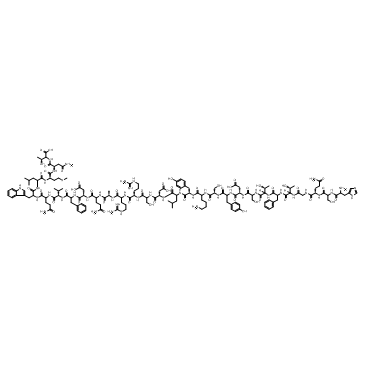| Cas No.: | 16941-32-5 |
| Synonyms: | Porcine glucagon |
| SMILES: | O=C(N[C@@H](CC(C)C)C(N[C@@H](CCSC)C(N[C@@H](CC(N)=O)C(N[C@H](C(O)=O)[C@H](O)C)=O)=O)=O)[C@@H](NC([C@H](CCC(N)=O)NC([C@H](C(C)C)NC([C@@H](NC([C@H](CC(O)=O)NC([C@H](CCC(N)=O)NC([C@H](C)NC([C@H](CCCNC(N)=N)NC([C@H](CCCNC(N)=N)NC([C@H](CO)NC([C@H](CC(O)=O)NC( |
| Formula: | C153H225N43O49S |
| M.Wt: | 3482.75 |
| Purity: | >98% |
| Sotrage: | 2 years -20°C Powder, 2 weeks 4°C in DMSO, 6 months -80°C in DMSO |
| Description: | Glucagon is a peptide hormone that helps regulate the blood sugar (glucose) levels in the body. |
| In Vitro: | Glucagon corrects dyslipidemia, obesity, and hyperglycemia in DIO mice. When glucagon binds to the glucagon receptors, the liver cells convert the glycogen into individual glucose molecules and release them into the bloodstream, in a process known as glycogenolysis[1][2]. |
| References: | [1]. Finan B et al. Chemical Hybridization of Glucagon and Thyroid Hormone Optimizes Therapeutic Impact for Metabolic Disease. Cell. 2016 Oct 20;167(3):843-857. [2]. Kristensen PL et al. Impact of the TCF7L2 genotype on risk of hypoglycaemia and glucagon secretion during hypoglycaemia. Endocr Connect. 2016 Oct 10. |

 DC Chemicals' products qualify for U.S. tariff exemptions. We guarantee no price increases due to customs duties and maintain stable supply, continuing to deliver reliable research solutions to our American clients.
DC Chemicals' products qualify for U.S. tariff exemptions. We guarantee no price increases due to customs duties and maintain stable supply, continuing to deliver reliable research solutions to our American clients.





















